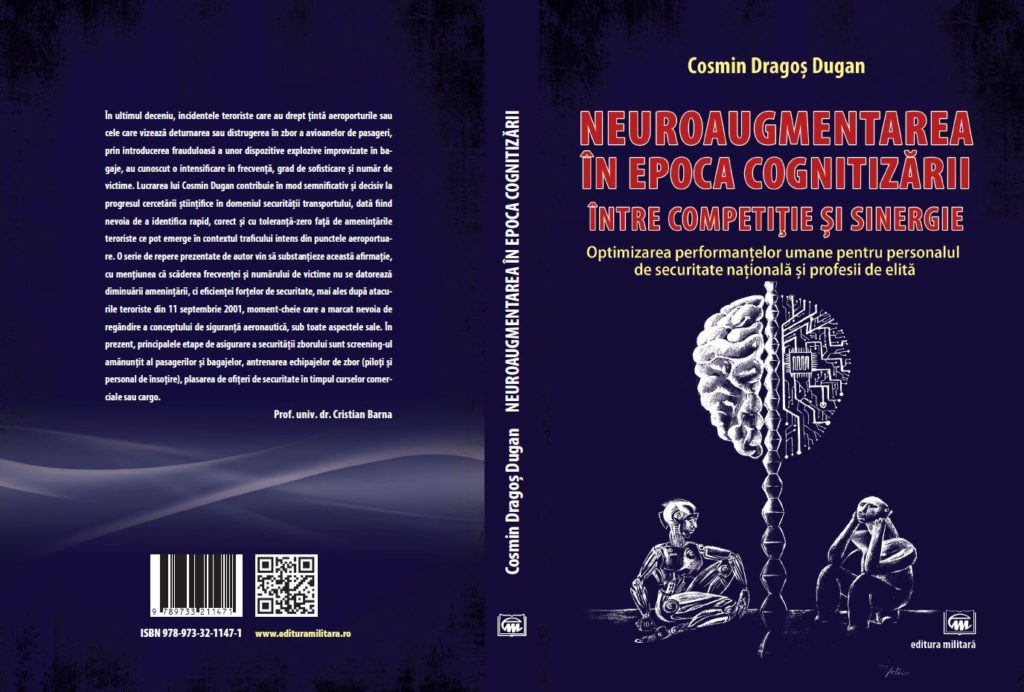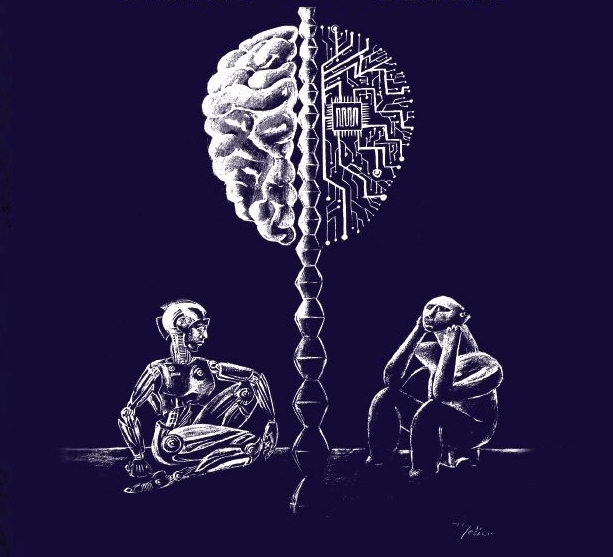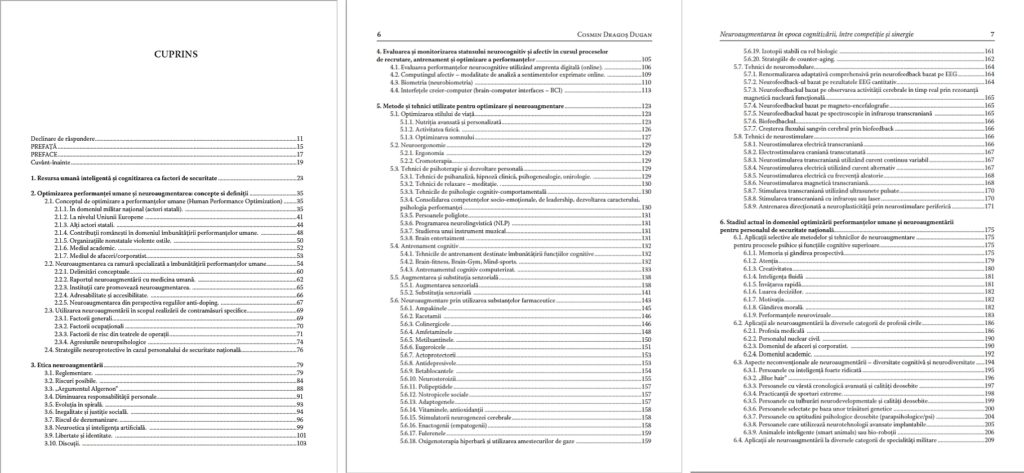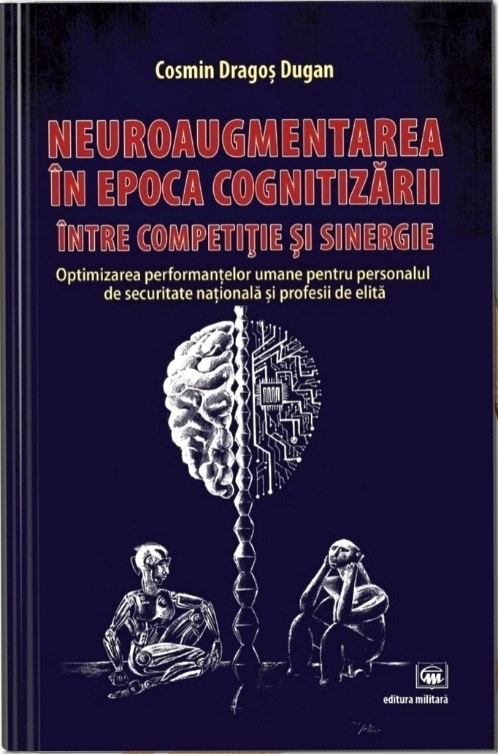To our knowledge, this is the first book published in Romania that simultaneously explores topics such as operational neurosciences, human performance optimization, neuroaugmentation, wearable and implantable neurotechnologies, and promotes practical human performance optimization applications for the military and civilian professions.
The first chapter highlights the impact achieved by the global acceleration of the informational metabolism, especially in the business, intelligence and military fields. We consider that educated human minds and the expansion of computational power, advanced artificial intelligence solutions and global electronic communication networks are the main catalysts placed at the epicenter of this revolution. Cognitization is considered as an inevitable step in the progress and expansion of digitization, which is responsible for the generation of a tremendous volume of data tat is impossible to be analyzed in real time by human operators. Artificial intelligence is a technological breakthrough that will probably become the herald of the human social progress at least in the first half of this century. In the intelligence and military environments, the accelerated development of artificial intelligence, human-machine collaboration, robotics and the achievement of “cognitive dominance” has already changed the physiognomy of conflicts in the first part of the 21st century and has emphasized the importance of talented, highly intelligent, professionalized and loyal human resources. At present we observe how the volatility of the traditional security environment and the ambiguity resulted from the erosion of borders between the virtual and reality, internal affairs and foreign relations, commercial and military field, peace and conflict etc., forced the western intelligence organizations to evolve towards a fourth generation espionage, understood as the merger between traditional human skills and accelerated technological progress which involves new partnerships and approaches that assimilate diversity and offer opportunities for the younger generation.

In the second chapter we define and explain the main concepts used in the book, such as operational neuroscience, human performance optimization or neuroaugmentation. We present several studies, reports, books, research projects, events and other benchmarks from various sources (the United States, the European Union, other state actors; from the military or civilian academic field) that played a central role in defining these concepts. Neuroaugmentation is presented as a specialized branch of human performance improvement, which has great research, economic and military potential in the coming decades. Currently, neuroaugmentation is in an experimental and exploratory stage, the reasons of the potential developers and users, the perception and public opinion, the means used and its consequences being put under scrutiny. Without a doubt, there is also a reverse of the sometimes excessive optimism with which this interdisciplinary field is perceived and reflected in sociological studies and artistic creations, manifested in the form of ethical, controversial and inconsistent theoretical limitations that are also mentioned or detailed in the text. In particular, we emphasize the ethical use of neuroaugmentation in order to achieve specific countermeasures in the case of complex professions with activities that are carried out in hostile environments or are characterized by frequent exposure to health risks, the said professions requiring special skills and exceptional neuro-cognitive and behavioral performances. Personalized countermeasure plans can be a component of long-term neuroprotective strategies for professionals working in elite military and civilian fields.
Besides the practical difficulties, estimated to be overcame in the coming decades, the ethical issues prompted by neuroaugmentation represent a major limitation that condition the development and acceptance of this field as a legitimate, regulated and secure niche. A first dilemma presented in the third chapter dedicated to the ethics of neuroaugmentation is that of the institutions and actors involved in the reglementation and the management of the social consequences resulted in the case of large-scale use of neurotechnologies and neuroaugmentation. We analyze possible risks, dissolution of personal responsibility, accentuated inequality, aggravation of discrimination and of social injustice, the spiral evolution towards increasingly radical methods of augmentation, the risk of dehumanization and loss of individual identity and freedom, problematic issues resulted from the interaction between artificial intelligence and human behavior, the role and impact of neuroethics in shaping a coherent legislative body (“neuro-laws”).
The fourth chapter of the paper is dedicated to the evaluation and monitoring of neurocognitive and affective status during the recruitment, training and performance optimization process. The identification of the quantitative and qualitative descriptive functional parameters, capable of carrying out an adequate assessment of the neurocognitive and emotional status and performances, is still a challenge for neuroscience. We present various methods used for advanced behavioral analysis that are involving digital fingerprinting, online sentiment analysis, neurobiometric measurements and brain-computer interfaces.

The techniques and methods used to improve cognitive, affective and behavioral performances are based on various principles of action, they use the medical information or are adapted from medical and paramedical procedures from several medical specialties (e.g. neurology, sports medicine, hyperbaric and aerospace medicine, medical rehabilitation, medical psychology, sports nutrition, etc.) and may have general or more restrictive indications, which require strict medical supervision. This complex repository used for cognitive optimization and augmentation has led us to dedicate a distinct chapter to a description and a concentrated presentation of the most relevant theoretical and practical issues. Depending on the mode of action and administration, the magnitude of the known or estimated optimization outcome, the potential risks, etc. we identified eight major groups of techniques and methods: lifestyle optimization, neuroergonomics, psychotherapy and personal development techniques, cognitive training, the use of pharmaceutical substances, neuromodulation and neurostimulation techniques.
In the sixth chapter of the book we highlight the impact and the practical use of the optimization and neuroaugmentation techniques and methods in various military specialties and civilian professions. The chapter is organized into four sub-chapters or interconnected parts: applications of neuroaugmentation for the selective optimization of higher psychic processes or cognitive functions (attention, memory, concentration, neurovisual capacity, etc.), applications for civil professions (physicians, civil nuclear personnel, civil servants, business, academic field), cognitive diversity and applications for diverse military specialties (defense, national security, public order). We highlight the presentation of unconventional aspects of human performance, with applications in the field of national security – cognitive diversity and neurodiversity. We believe that by spotting, recruiting, training and professional assimilation of people with exceptional skills, decisive advantages can be obtained in order to achieve the strategic surprise or to avoid a major failure, also allowing the exploration of original, atypical offensive and defensive strategies outside the field of perception and understanding of the potential opponent. We comment on highly intelligent people, extreme sports practitioners, persons with special psychological skills, individuals who have neurodevelopmental disorders and special qualities, persons possessing desirable genetic traits, beneficiaries of advanced implantable neurotechnologies, people with advanced chronological age and special skills, ” blue hair” people and smart animals.

In the last chapter we state our conclusions and outline the most important applications, benefits and observations from the theoretical and practical research carried out. We emphasize the importance of regulation, ethical and legislative dilemmas in the case of large-scale implementation of neuroaugmentation techniques and methods. We consider that the ethical and efficient use of neuroaugmentation must be supported by public health and sociological studies regarding the motivation, intention, acquisition, consumption and effects observed in the users of pharmaceutical substances or other practices carried out for augmentative purposes in the academic environment and through awareness and education campaigns.
This approach should also be supported by the foundation of a Romanian lexicon dedicated to cognitive optimization, neuroaugmentation and related fields. It is our opinion that it is imperative to develop a domestic vision, based on incentives such as university and post-university research grants in the field of neurosciences. This research infrastructure will be able to deal with various problems generated as a result of the designing and implementation of neuroprotective, optimization and neuroaugmentation programs for national security professions.
The development of operational neurosciences, as an integrative and interdisciplinary approach, focused on pragmatic aspects of security, will further contribute to the maturing of military neurotechnologies. The development of precision countermeasures for specific aggression factors is an important direction of exploiting the concept of optimizing human performance.
Last but not least, we highlight the potential risks, such as the possibility that performance improvement methods may become dual-use technologies, especially when they involve the use of advanced artificial intelligence and robotic applications or to be employed for the development of reversible and scalable neurodegradation strategies for coercive or extortion purposes.
The appendix plays an important role in completing the information contained in the book. The first appendix contains a short lexicon with technical terms and neologisms mentioned in the text, including terms that are not yet approved for use in the current Romanian language and are taken from the foreign specialized literature (especially Anglo-Saxon). This initiative represents one of the original elements of the paper and, we hope, a first step in the direction of the validation and introduction in the Romanian vocabulary of the terminology needed to define and develop operational neurosciences and neuroaugmentation. The second annex contains some considerations about the cultural dimension of operational neuroscience, cognitive optimization and neuroaugmentation, applications for civil and military professions, etc., which we consider useful in order to draw a clearer demarcation between fiction, expectation and reality. In the third annex several medical studies on neuroaugmentation are mentioned, which in our opinion contribute to underlining the legitimacy, usefulness and potential of this interdisciplinary niche. In the last annex graphic materials resulting from the experiments performed and described in the seventh chapter are presented and explained.







